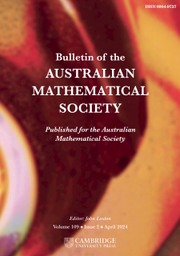We consider a class of nondoubling manifolds
![]() $\mathcal {M}$
consisting of finitely many ‘Euclidean’ ends, where the Euclidean dimensions at infinity are not necessarily all the same. From Hassell and Sikora [Reference Hassell and Sikora1], it is known that the Riesz transform on
$\mathcal {M}$
consisting of finitely many ‘Euclidean’ ends, where the Euclidean dimensions at infinity are not necessarily all the same. From Hassell and Sikora [Reference Hassell and Sikora1], it is known that the Riesz transform on
![]() $\mathcal {M}$
is of weak type
$\mathcal {M}$
is of weak type
![]() $(1,1)$
, bounded on
$(1,1)$
, bounded on
![]() $L^{p}$
if and only if
$L^{p}$
if and only if
![]() $1<p<n_*$
, where
$1<p<n_*$
, where
![]() $n_* = \min _k n_k$
. We complete the picture by giving an endpoint estimate [Reference He3]: the Riesz transform is bounded on the Lorentz space
$n_* = \min _k n_k$
. We complete the picture by giving an endpoint estimate [Reference He3]: the Riesz transform is bounded on the Lorentz space
![]() $L^{n_* ,1}$
and unbounded from
$L^{n_* ,1}$
and unbounded from
![]() $L^{n_*,p}\to L^{n_*,q}$
for all
$L^{n_*,p}\to L^{n_*,q}$
for all
![]() $1<p<\infty $
and
$1<p<\infty $
and
![]() $p\le q\le \infty $
. To delve deeper into the topic, we also establish endpoint estimates for Riesz transforms on a metric cone with potential and manifolds with quadratically decaying Ricci curvature. As a supplement, some results about the Riesz transform on a one-dimensional model, the broken line, have been given [Reference He6].
$p\le q\le \infty $
. To delve deeper into the topic, we also establish endpoint estimates for Riesz transforms on a metric cone with potential and manifolds with quadratically decaying Ricci curvature. As a supplement, some results about the Riesz transform on a one-dimensional model, the broken line, have been given [Reference He6].
To further our study and due to its intrinsic interest, we delve into the topic of isoperimetric and Sobolev inequalities [Reference He4]. On the manifolds with quadratically decaying Ricci curvature, we first demonstrate that the nice heat kernel regularity on remote balls allows us to get a standard isoperimetric inequality on such manifolds. Similarly, even though the classical isoperimetric inequality does not apply, a generalised isoperimetric formulation can be established for manifolds with ends.
In our next investigation, we focus on the reverse Riesz transform within the framework of manifolds with ends [Reference He2]. We rigorously confirm the boundedness of this transform across all
![]() $L^p$
spaces for
$L^p$
spaces for
![]() $1<p<\infty $
. Notably, existing knowledge indicates that the Riesz transform in such a context demonstrates boundedness solely within a specific range of
$1<p<\infty $
. Notably, existing knowledge indicates that the Riesz transform in such a context demonstrates boundedness solely within a specific range of
![]() $L^p$
spaces, typically observed for
$L^p$
spaces, typically observed for
![]() $1<p<n_*$
, where
$1<p<n_*$
, where
![]() $n_*$
signifies the smallest dimension of the manifold’s ends on a large scale. This observation serves as a significant counterexample to the presumed equivalence between the Riesz and reverse Riesz transforms. Our study illuminates the nuanced behaviour of these transforms within the setting of manifolds with ends, providing valuable insights into their distinct properties [Reference He5]. Although the lack of equivalence has been previously noted in relevant literature, our investigation contributes to a deeper understanding of the intricate interplay between the Riesz and reverse Riesz transforms. In the same spirit, we also obtain a reverse inequality on manifolds with quadratic curvature decay and the broken line.
$n_*$
signifies the smallest dimension of the manifold’s ends on a large scale. This observation serves as a significant counterexample to the presumed equivalence between the Riesz and reverse Riesz transforms. Our study illuminates the nuanced behaviour of these transforms within the setting of manifolds with ends, providing valuable insights into their distinct properties [Reference He5]. Although the lack of equivalence has been previously noted in relevant literature, our investigation contributes to a deeper understanding of the intricate interplay between the Riesz and reverse Riesz transforms. In the same spirit, we also obtain a reverse inequality on manifolds with quadratic curvature decay and the broken line.
Finally, we explore the relationship between the complex-time resolvent and spectral multipliers, demonstrating their essential equivalence under certain smoothness conditions on the multiplier. As an application, we verify that manifolds with ends satisfy the necessary resolvent conditions, allowing us to establish multiplier results for these types of nondoubling manifolds.


